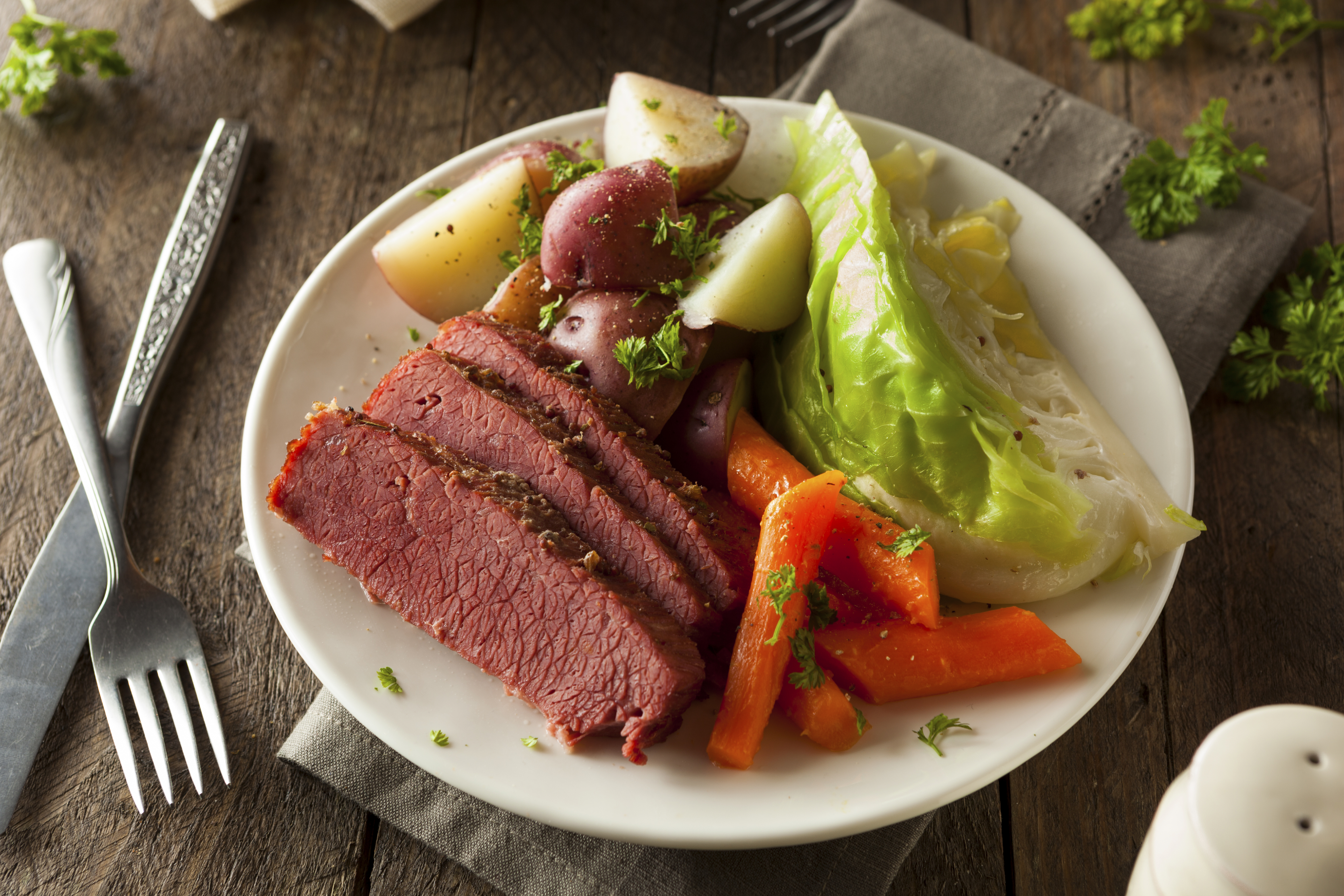As in most developing ancient European societies, the transition from Stone Age to the Bronze Age had a dramatic affect on what the people of Ireland ate and how they prepared it.
The development of malleable, heat-tolerant materials meant that foods could be cooked in a vessel using moist-heat methods, rather than solely by dry heat over or in an open fire. The most primitive method of moist heat cooking is boiling—meat and or vegetables cooked in water until palatable.
In ancient times, the cauldron—a large three-legged pot suspended over a fire—was the most common cooking vessel, and it can be traced to the origins of so many traditional Irish soups, stews, and braises we know and love today. The earliest ovens were simply cauldrons turned upside down and placed over a fire.

Today, unfortunately, Irish food has a reputation for being bland and starchy. The omnipresence of potatoes, cabbage, and oats—not highly flavored ingredients on their own—is at the basis of the conjecture.
True, the history of Irish cuisine reflects one of poverty and struggle through troubled times. It does not aspire to the heights of creativity and excesses of French cuisine, for example, a portion of which developed because of the appeal to the extravagances and amusement of royalty, the rich and powerful.
However, Irish cuisine can be viewed as simple. And, when the ingredients are the best that can be found, simplicity can be the key to unique and delicious.
Being an island nation about the size of the state of Indiana, Ireland’s cuisine brings together local supplies of foods raised on the land and harvested from local seas, streams, and lakes.
Milk, cheese, meat, cereals—especially oats—and some vegetables formed the main part of the Irish diet from prehistoric times up until the introduction of the potato nearly 600 years ago. Oats were fundamental to the Irish diet because they were a double-duty food for the family, as well as feed for the livestock. Oatmeal porridge and oatmeal breads are favorites.
Coastal communities used a variety of shellfish (clams, oysters, mussels, prawns, crabs, and more), then added seaweed, herbs, and vegetables to make soups, stews, and pies. Long-simmered dishes were eaten with the ever-present and substantial oat bread.
Prior to the potato, cattle, lamb, and pork dominated the rural economy and, therefore, played a large role in Irish food.
A major impact on the Irish diet was the discovery of the New World. About 75 years after Columbus, the potato was one of a few new and exotic food crops introduced to Europeans.
Potatoes were first brought to the European continent by Spanish explorers returning from the New World in 1570. Within 20 years, the new tuber had spread throughout Europe and to the British Isles. Two hundred years later, potatoes, along with oats, were generally regarded as staples of the Irish diet—one born from poverty, necessity, and thrift. From the early 18th century onward no meal was considered complete without potatoes. By 1770, the potato was known as the Irish Potato.
Although Ireland sustained famines through the years, the worst occurred in the 1840s when a potato blight ravaged crops, killing millions over a several-year span and resulting in a major emigration of Irish people to the United States.
Among the best-known favorites of Irish cuisine are:
- Soda Bread – A quick bread that uses baking soda as a leavener instead of yeast.
- Bram-brack – Dried fruit (currants, raisins, dates), soaked overnight in hot tea, then baked with spice, egg, orange marmalade, sugar, and flour. Slice and serve buttered with a cup of tea.
- Champ – Mashed potatoes with green onion, with a well of butter in the center. Typically, the dish is consumed by eating the potatoes from the side and dipping in the butter.
- Colcannon – Mashed potatoes, shredded cabbage, and onions.
- Irish Stew – Simple stew made of lamb or mutton, potatoes, and onions. For added depth of flavor, people threw in a measure of stout.
- Boxty – Simple potato pancakes. The traditional recipe called for grated raw potatoes, leftover mashed potatoes, baking powder, and sweet milk. More contemporary versions are flavored with onions and/or garlic.
- Dublin Coddle – Simple stew from pork, sausage, potatoes, and onions. The name comes from the slow coddling or simmering of the dish. This stick-to-the-ribs dish is hearty and filling.
- Bangers – A sausage traditionally made with pork, beef varieties are now also common. Sausage has always been about thrift, and bangers are probably the thriftiest of all. During World War II rationing and shortages, bangers were invented and got their name from the fact that breadcrumbs were used to substitute for a full measure of pork. The moisture-heavy breadcrumbs caused the sausage to explode, or “bang,” while being cooked in the pan.
- Irish Coffee – Made from muddling raw sugar with good Irish whiskey—Jameson or John Powers are good choices—whipped cream and bold coffee.
- Guinness – Ireland’s most famous beer—a stout, to be precise. It’s so dense and hearty, it’s almost a meal in itself.
- Irish Breakfast Tea – A hearty black tea that is the preeminent choice all over Ireland. It’s name is synonymous with the word itself: tea.
- Corned Beef and Cabbage – This is probably the most famous boiled dish in all of Ireland and a must-have dish for any bar, pub, or restaurant celebrating St. Patrick’s Day.



Leave Your Response